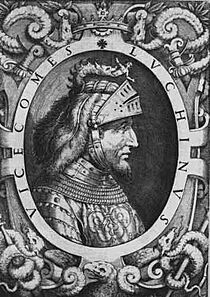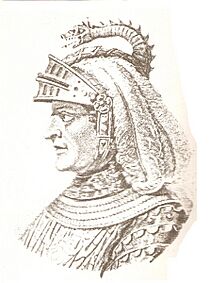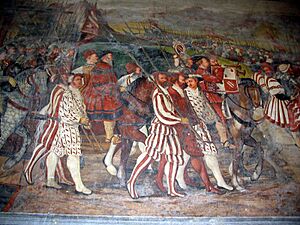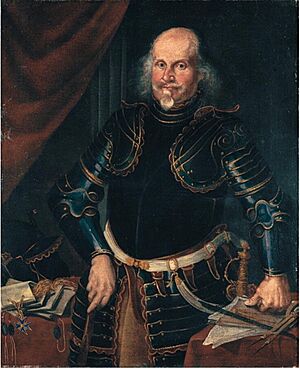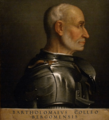Condottiero facts for kids
Condottieri (say "kon-dot-tee-AIR-ee") were powerful Italian military leaders. They commanded groups of mercenary soldiers, who were fighters for hire. These leaders and their armies were very important in Italy during the Middle Ages and the early modern period.
They often worked for popes and kings across Europe, especially during the Italian Wars and the European Wars of Religion. Famous condottieri included Giovanni dalle Bande Nere, Cesare Borgia, and Andrea Doria.
The word condottiero comes from an old Italian word meaning 'contractor'. This is because a condotta was the contract they signed to work for a city or a lord. Over time, the word just meant "military leader." Some people even call Napoleon Bonaparte the "last condottiero" because of his Italian background. Most historians, however, focus on the period from about 1350 to 1650. This was when these hired army leaders became very powerful in Europe.
Contents
Hired Army Leaders
How They Started
In the 1200s and 1300s, Italian city-states like Venice and Florence were very rich. They made a lot of money from trading goods. But these cities had very small armies. So, when other countries or neighbors attacked, the rich rulers hired foreign soldiers to fight for them.
The rules for military service were written in a contract called a condotta. This contract was between the city and the soldiers. The leader who signed this contract and commanded the hired army was called a "Condottiere."
From the 1000s to the 1200s, European soldiers fought in the Crusades against Muslims. These wars gave officers a lot of experience in large battles. After the Crusades ended, groups of wandering soldiers, called masnade, appeared in Italy. Some of these groups were more like bandits than soldiers.
Many of these early mercenaries were not Italian. They came from places like Flanders and Aragon. Spanish soldiers who fought in the War of the Sicilian Vespers in 1282 stayed in Italy looking for work. By 1333, more mercenaries arrived, like the "Company of the Dove." The first well-organized mercenary groups were led by Duke Werner von Urslingen and Count Konrad von Landau. Werner's company was special because it had strict rules and shared the money equally. This group grew into the famous "Great Company" with about 3,000 knights and sergeants.
Becoming Powerful
The first mercenary group led by an Italian was the "Company of St. George" in 1339. It was led by Lodrisio Visconti. This company was later defeated by Luchino Visconti of Milan. Later, in 1377, another "Company of St. George" was formed. It was led by Alberico da Barbiano, who was also Italian. He taught military skills to other future condottieri like Braccio da Montone and Giacomuzzo Attendolo Sforza.
Once condottieri realized how much military power they had, they became very demanding. They often set their own terms for their employers. Many condottieri, like Braccio da Montone, even became powerful politicians. They were educated and studied old Roman military books. This made them see war as a science, not just about bravery. This was a big change from the old idea of chivalry.
Because of this, condottieri often tried to outsmart their enemies. They avoided big, risky battles that could lead to defeat or death. They didn't want to lose their trained soldiers. Niccolò Machiavelli, a famous writer, even said that condottieri often fought battles that looked grand but had very little bloodshed. However, later on, condottieri armies still used old-fashioned knights and weapons. Meanwhile, other European armies started using professional soldiers with pikemen and musketeers. This helped lead to the condottieri's decline.
In 1347, a Roman leader named Cola di Rienzo had Werner von Urslingen executed. Count Konrad von Landau then took over the Great Company. After a peace treaty between England and France in 1360, Sir John Hawkwood led an English mercenary army, called the White Company, into Italy. This company played a big part in the wars of the next 30 years.
By the end of the 1300s, Italians started forming their own mercenary armies. This led to the end of purely foreign mercenary groups and the start of semi-national mercenary armies in Europe. In 1363, Count von Landau was defeated by the White Company's new tactics. At this time, the way soldiers were organized changed. Condottieri companies became a mix of Italian and foreign soldiers. Examples include the "Company of the Star" and a new "Company of St. George."
From the 1400s onwards, most condottieri were Italian nobles who didn't own much land. They chose to be soldiers to make a living. One of the most famous was Giovanni dalle Bande Nere, known as 'The Last Condottiere'. Even princes became condottieri because of the good income. For example, Sigismondo Pandolfo Malatesta and Federico da Montefeltro were both condottieri. Soldiers' pay was very high back then:
- In 1432, Micheletto Attendolo earned 1,900 florins a month.
- In 1448, William VIII of Montferrat earned 6,600 florins a month.
- In 1505, Francesco II Gonzaga earned 33,000 scudi a year for 250 men.
Condottieri leaders chose their own soldiers. The condotta was a complete contract. When the service period ended, there was a waiting time for the city to decide if they wanted to renew the contract. If the contract ended for good, the condottiere could not declare war against that city for two years. This rule was respected because their reputation was very important for their business.
In 1400s Italy, condottieri were true masters of war. Machiavelli noticed that most Italian states didn't have their own armies. They relied on these hired forces. The condottieri fought for money or to gain honor.
Their Decline
Over time, the condottieri's focus on money and power caused problems. They often avoided bloody battles and sometimes even took bribes. By the end of the 1400s, Italy was drawn into bigger European wars. Powerful armies from France, Spain, and Germany arrived. The condottieri armies, with their older fighting styles, couldn't compete with these new, stronger forces. So, they slowly disappeared.
The condottieri's soldiers were mostly heavily armored cavalry (knights). Before 1400, they didn't have much in common with the people they fought for. Their behavior was often wild and greedy. They were always ready to switch sides for more money. An enemy today could be a friend tomorrow. Also, capturing a prisoner was often more valuable than killing an enemy. This meant their battles were often more like shows than bloody fights.
The invention of firearms and gunpowder also led to their decline. Even though condottieri were among the first to use new weapons, their old-fashioned fighting style became useless. War changed from fancy displays of power to a more brutal fight for everyone. They were not ready for this change.
Great Generals
In 1494, the French king Charles VIII invaded Italy. This started the Italian Wars. Many famous condottieri then fought for foreign countries. For example, Gian Giacomo Trivulzio left Milan to fight for France. Andrea Doria became an admiral for the Holy Roman Emperor Charles V.
By 1550, the old condotta military contracts were gone. But the term condottiere still referred to great Italian generals who fought for other countries. Men like Alexander Farnese and Prospero Colonna were important generals in the 1500s and 1600s. Even today, the Vatican's Swiss Guard is a modern example of a hired army.
The end of the Thirty Years' War in 1648 changed Europe. It led to bigger, stronger countries. Italy, however, remained divided. The condottieri tradition suffered greatly from Italy's political decline and never fully recovered.
More to Explore
Images for kids
-
Bartolomeo Colleoni won a battle in 1447.
-
Ambrogio Spinola, one of the last great condottieri.
See also
 In Spanish: Condotiero para niños
In Spanish: Condotiero para niños



